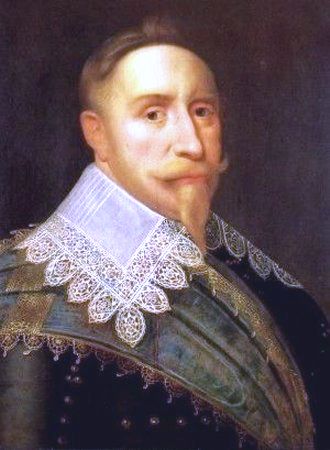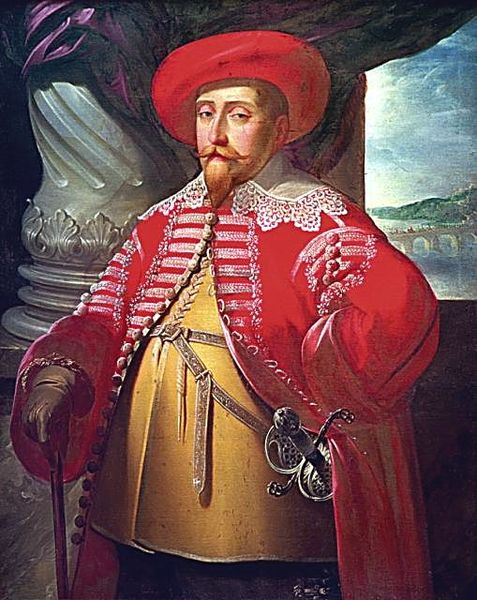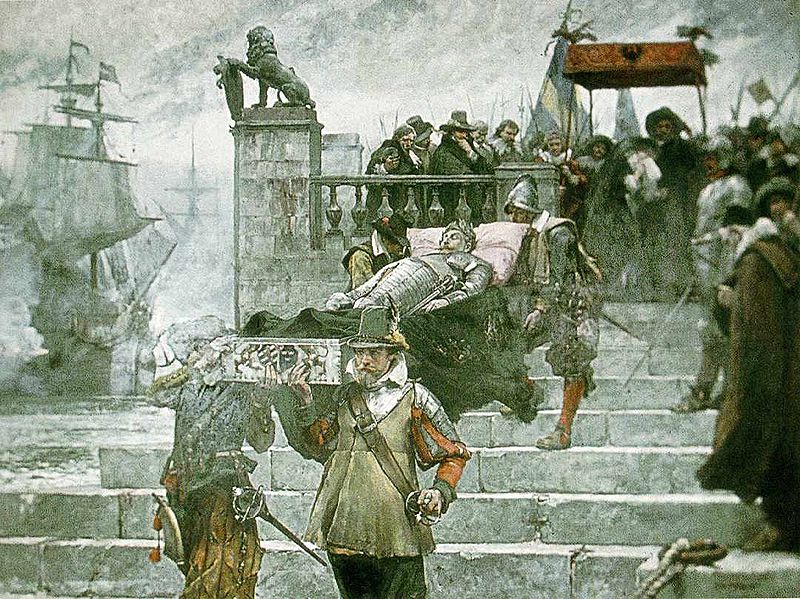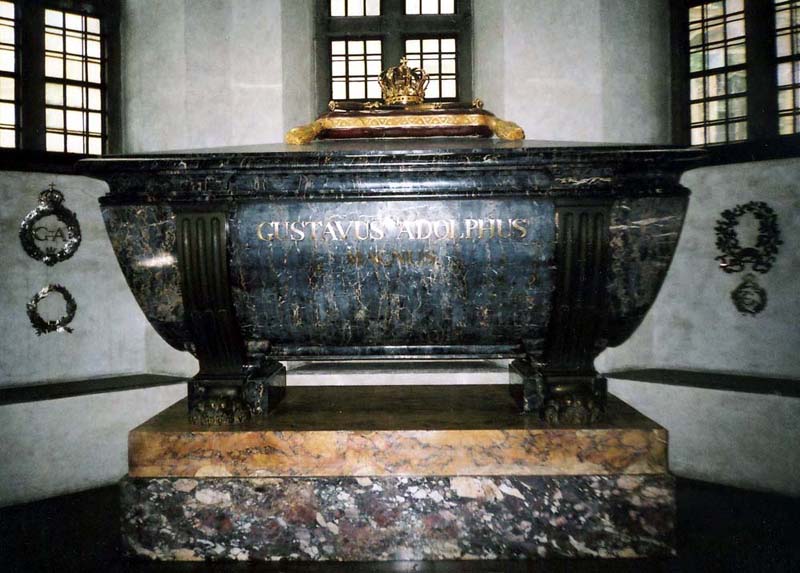<Back to Index>
- Mathematician Nikolai Nikolaevich Luzin, 1883
- Bluesman Junior Wells, 1934
- King of Sweden Gustav II Adolf, 1594
PAGE SPONSOR


Gustav II Adolf (9 December 1594 – 6 November 1632), widely known in English by the Latinized name Gustavus Adolphus and variously in historical writings sometimes as simply just Gustavus, or Gustavus the Great, or Gustav Adolf the Great, (Swedish: Gustav Adolf den store, from the special distinction passed by the Swedish Parliament in 1634), was founder of the Swedish Empire (or Stormaktstiden – "the era of great power") at the beginning of the Golden Age of Sweden. He was the King of Sweden (1611 - 1632) who led the nation to military supremacy during the Thirty Years War, helping to determine the political as well as the religious balance of power in Europe. His most notable military victory was the Battle of Breitenfeld (1631). With a superb military machine with good weapons, excellent training, and effective field artillery, all backed by a highly efficient government back home that paid the bills on time, Gustavus Adolphus was poised to make himself a major European leader, but he was killed in battle in 1632. He was assisted by Axel Oxenstierna (1583 - 1654), leader of the nobles who also acted as regent after his death.
In the era, which was characterized by nearly endless warfare, he led his armies as king from 1611 (at age 17) until his death in battle while leading a charge during 1632 — as Sweden rose from the status as a mere regional power and run-of-the-mill kingdom to one of the great powers of Europe and a model of early modern era government. Sweden expanded to become the third biggest nation in Europe after Russia and Spain within only a few years during his reign. Some have called him the "father of modern warfare", or the first great modern general. Under his tutelage, Sweden and the Protestant cause developed a number of excellent commanders, such as Lennart Torstensson, who would go on to defeat Sweden's enemies and expand the boundaries and the power of the empire long after Gustav Adolph's death in battle. He was known by the epithets "The Golden King" and "The Lion of the North" by neighboring sovereigns. Gustavus Adolphus is today commemorated by city squares in Stockholm, Gothenburg and Sundsvall. Gustavus Adolphus College, a Lutheran college in St. Peter, Minnesota, is also named for the Swedish king.
Gustavus Adolphus was born in Stockholm as the oldest son of Duke Charles of the Vasa dynasty and his second wife, Christina of Holstein-Gottorp. At the time the King of Sweden was Gustavus Adolphus' cousin Sigismund.
The staunch Protestant Duke Charles forced the Catholic King to let go
of the throne of Sweden in 1599, a part of the preliminary religious
strife before the Thirty Years' War, and reigned as regent before taking the throne as Charles IX of Sweden in
1604. Upon his father's death in 1611, a seventeen year-old Gustavus
inherited the throne as well as an ongoing succession of occasionally
belligerent dynastic disputes with his Polish cousin. Sigismund III
wanted to regain the throne of Sweden and tried to force Gustavus
Adolphus to renounce the title. In a round of this dynastic dispute, Gustavus invaded Livonia when he was 31, beginning the Polish-Swedish War (1625 – 1629).
He intervened on behalf of the Lutherans in Germany, who opened the
gates to their cities to him. His reign became famous from his actions
a few years later when on June 1630 he landed in Germany, continuing
Sweden's involvement in the ongoing Thirty Years' War.
Gustavus intervened on the anti-Imperial side, which at the time was
losing to the Holy Roman Empire and its Catholic allies; the Swedish
forces would quickly reverse that situation. Gustavus was married to Maria Eleonora of Brandenburg, the daughter of John Sigismund, Elector of Brandenburg, and chose the Prussian city of Elbing as the base for his operations in Germany. He died in the Battle of Lützen in
1632. His early death was a great loss to the Lutheran side. This
resulted in large parts of Germany and other countries, which for a
large part had become Lutheran, to be returned to Catholicism (via Counter-Reformation). His involvement in the Thirty Years' War gave rise to the old prophecy that he was the incarnation of "the Lion of the North", or as it is called in German "Der Löwe von Mitternacht" (Literally: "The Lion of Midnight"). Gustavus
Adolphus was known as an able military commander. His innovative
tactical integration of infantry, cavalry, artillery and logistics
earned him the title of the "Father of Modern Warfare". Future
commanders who studied and admired Gustav II Adolf include Napoleon I of France and Carl von Clausewitz. His advancements in military science made Sweden the dominant Baltic power for the next one hundred years. He is also the only Swedish monarch to be styled "the Great".
This decision was made by the Swedish Estates of the Realm, when they
convened in 1633. Thus, by their decision he is officially, to this
day, to be called Gustaf Adolf the Great (Gustavus Adolphus Magnus). Gustavus
Adolphus was the main figure responsible for the success of Sweden
during the Thirty Years' War and led his nation to great prestige. As a general, Gustavus Adolphus is famous for employing mobile artillery on the battlefield, as well as very aggressive tactics,
where attack was stressed over defense, and mobility and cavalry
initiative were emphasized. Among other innovations, he installed an
early form of combined arms in
his formations, where the cavalry could attack from the safety of an
infantry line reinforced by cannon, and retire again within to regroup
after their foray. He adopted much shallower infantry formations than
were common in the pike and shot armies
of the era, with formations typically fighting in 5 or 6 ranks,
occasionally supported at some distance by another such formation — the
gaps being the provinces of the artillery and cavalry as noted above.
His artillery were themselves different — he would not let himself be
hindered by cumbersome heavy cannon, but instead over a course of
experimentation settled on smaller, more maneuverable weapons, in
effect fielding the first light field artillery in history in any
significant ratios.These
were grouped in batteries supporting his more linearly deployed
formations, replacing the cumbersome and unmaneuverable traditional
deep squares (such as the Spanish Tercios that
were up to 50 ranks deep) used in other pike and shot armies of the
day. In consequence, his forces could redeploy and reconfigure
extremely rapidly, confounding his enemies. His armies were very well trained for the day, so that his musketeers were widely known for their firing accuracy and reload speed: three times faster than any contemporary rivals. Carl von Clausewitz and Napoleon Bonaparte considered him one of the greatest generals of all time; a sentiment agreed with by Patton and
others. He was also renowned for the consistency of purpose and the
amity of his troops — no one part of his armies was considered better or
received preferred treatment, as was common in other armies where the
cavalry were the elite, followed by the artillery, and both disdained
the lowly infantry. In Gustavus' army the units were extensively cross
trained. Both cavalry and infantry could service the artillery, as his
heavy cavalry did when turning captured artillery on the opposing
Catholic Tercios at First Breitenfeld.
Pikemen could shoot — if not as accurately as those designated
musketeers — so a valuable firearm could be kept in the firing line. His
infantrymen and gunners were taught to ride, if needed. Napoleon thought highly of the achievement, and copied the tactics. Gustavus
Adolphus inherited three wars from his father when he ascended the
throne: Against Denmark, which had attacked Sweden earlier in 1611,
against Russia, due to Sweden having tried to take advantage of the
Russian Time of Troubles, and against Poland, due to King Charles' having deposed King Sigismund III. The
war against Denmark was concluded in 1613 with a peace that did not
cost Sweden any territory, but it was forced to pay a heavy indemnity
to Denmark. The war against Russia ended in 1617 with the victorious
Peace of Stolbova, which excluded Russia from the Baltic Sea. The final
inherited war, the war against Poland, ended in 1629 with the Armistice
of Altmark which transferred the large province Livonia to Sweden. At
that time, Gustavus Adolphus' focus had moved on to the Protestants'
troubled situation in war-torn Germany. In
his first military action when a new king, he attacked eastern Denmark
(now southern Sweden) and let his soldiers plunder towns and villages
as was customary in contemporary warfare, but later strictly prohibited
in his campaigns. His memory in Scania has
been negative because of that, though Denmark including Scania was
Protestant at the time and the King's anti-Catholic policy was one of
the reasons that led him across the Baltic Sea. When Gustavus Adolphus began his push into northern Germany in June-July 1630, he had just 4,000 troops. But he was soon able to consolidate the Protestant position
in the north, using reinforcements from Sweden and money supplied by
France. Meanwhile, a Catholic army under Tilly was laying waste to Saxony. Gustavus Adolphus met Tilly's army and crushed it at the First Battle of Breitenfeld in
September 1631, in spite of the collapse of his Saxon allies. He then
marched clear across Germany, establishing his winter quarters near The
Rhine, making plans for the invasion of the rest of the Holy Roman Empire. In March 1632, Gustavus Adolphus invaded Bavaria, a staunch ally of the Emperor. He forced the withdrawal of his Catholic opponents at the Battle of Rain.
This would mark the high point of the campaign. In the summer of that
year, he sought a political solution that would preserve the existing
structure of states in Germany, while guaranteeing the security of its
Protestants. But achieving these objectives depended on his continued
success on the battlefield. Gustavus
is reported to have entered battle without wearing any armor,
proclaiming, "The Lord God, is my armor!" It is more likely that he
simply wore a leather cuirass rather
than going into battle wearing no battle protection whatsoever. In
1627, near Dirschau in Prussia, a Polish soldier shot him in the
muscles above his shoulders. He survived, but the doctors could not
remove the bullet, so from that point on, he could not wear an iron
armor. Also, two fingers of his right hand were paralyzed. Gustavus Adolphus was killed at the Battle of Lützen, when, at a crucial point in the battle, he became separated from his troops while leading a cavalry charge into a dense smog of
mist and gunpowder smoke. After his death, his wife initially kept his
body, and later his heart, in the castle of Nyköping for over a
year. His remains (including his heart) now rest in Riddarholmskyrkan in Stockholm. In February 1633, following the death of the king, the Swedish Riksdag of the Estates decided that his name would be styled Gustav Adolf the Great (or Gustaf Adolf den Store in Swedish). No such honor has been bestowed on any other Swedish monarch before or since. The
crown of Sweden was inherited in the Vasa family, and from Charles IX's
time excluded those Vasa princes who had been traitors or descended
from deposed monarchs. Gustavus Adolphus' younger brother had died ten
years before, and therefore there were only the King's daughter left as
a female heir. Maria Eleonora and the king's ministers took over the
government on behalf of Gustavus Adolphus' underage daughter Christina upon her father's death. He left one other known child, his illegitimate son Gustav, Count of Vasaborg. The German Socialist Franz Mehring (1846 – 1919) wrote a biography of Gustavus Adolphus with a Marxist perspective
on the actions of the Swedish king during the Thirty Years' War. In it,
he makes a case that the war was fought over economics and trade rather
than religion. In his book "Ofredsår" ("Years of Warfare"), the Swedish historian and author Peter Englund argues
that there was probably no single all-important reason for the king's
decision to go to war. Instead, it was likely a combination of
religious, security, as well as economic considerations.
Gustav
II Adolf's success in making Sweden one of the great powers of Europe,
and perhaps the most important power in the Thirty Years' War after
France and Spain, was due not only to his military brilliance, but also
to important institutional reforms in Sweden's government. The chief
among these reforms was the institution of the first Parish registrations, so that the central government could more efficiently tax and conscript its populace.

